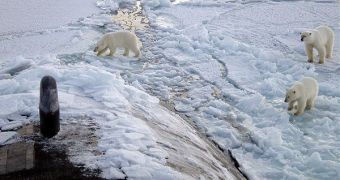Scientists analyzing the ancient climate history of the planet warn that the Arctic, the surrounding ocean, and the northern seas risk losing all their ices relatively fast. They add that numerous similarities exist between the expected temperature ranges in the next 90 years, and the records at hand for a period of time known as the mid-Pliocene. At that time, the Arctic was also barren, with no ices during the summer, because of the increased global temperatures.
The US Geological Survey (USGS) reports that, during the mid-Pliocene (3.3 to three million years ago), temperatures in the northern regions reached levels as high as ten to 18°C (50 to 64°F). For our current age, temperatures revolve around 0°C (32°F). Even now, these ranges prevent the formation of new, multi-annual ice layers. Unfortunately, recent investigations in the area have shown that the old ice is melting, and that new ice forms during the winter. However, in the summer, this type of ice melts a lot faster, and allows for the thicker layers underneath to be affected by the increased temperatures and warming water as well.
“In looking back 3 million years, we see a very different pattern of heat distribution than today with much warmer waters in the high latitudes. The lack of summer sea ice during the mid-Pliocene suggests that the record-setting melting of Arctic sea ice over the past few years could be an early warning of more significant changes to come,” USGS scientist Marci Robinson explains. During the mid-Pliocene, global, average, surface temperatures were at around 3°C (5.5°F). This is well within the predicted range for this century, according to the Intergovernmental Panel on Climate Change (IPCC).
The USGS team believes that this period in the Earth's history, three million years ago, is the most accurately reconstructed global warming in the history of the planet. This is the main reason why it is used as a basis for the construction of modern climate models. As researchers discover more and more data about the mid-Pliocene warming, the new knowledge is added to the models, refining them, and increasing their accuracy rates.

 14 DAY TRIAL //
14 DAY TRIAL //